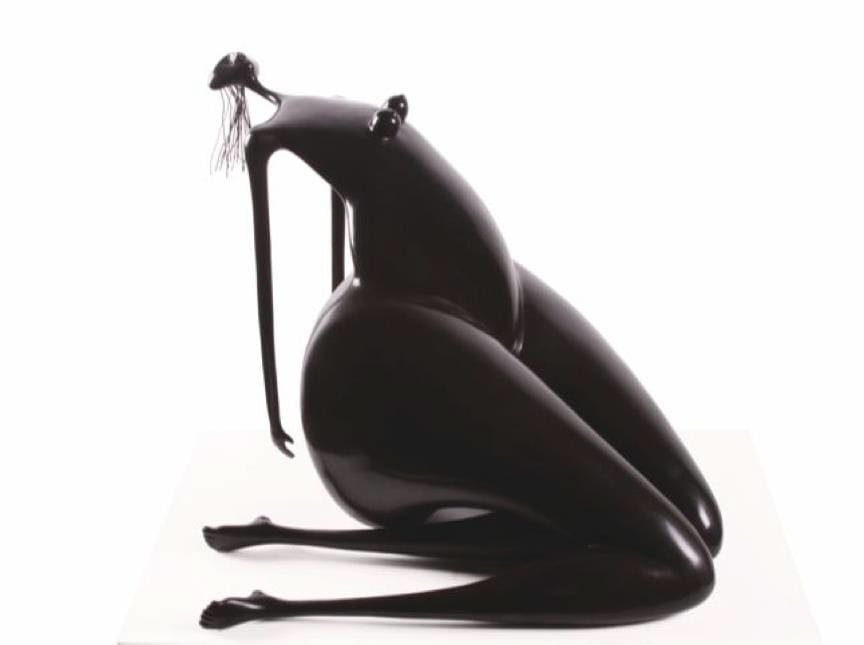Abigail Varela: Sculptures, showcasing over a dozen female bronze and aluminum sculptures by the internationally recognized Venezuelan artist, is on view through March 13, 2020.
The rotund and “Rubenesque” feminine portrayals give rise to a playful spectacle juxtaposed by academic and historical undercurrents. Drawing early inspirations from timeless pre-Columbian female artifacts, Varela pays homage to an embodiment of fertility and richness. Proportional distortions also evoke the likes of the Venus of Willendorf or African Dogon cultural adoptions.
Cross-trained in various disciplines, including mentoring under Japanese ceramist Hiroshi Kawagiri, Varela continued his arts education at esteemed art institutions in Caracas. Over the course of his prestigious career, Varela has exhibited in New York, London, San Salvador, Caracas, and elsewhere. His work has been shown prominently in the respected collections at the National Art Gallery–Caracas, Empresas Polar Foundation, Fundacion Cultura Chacao, Suncheon Bay National Garden–Korea and the National Sculpture Hall of the Barquisimento Museum, among others.
For epochs, the female figure has been celebrated in the arts. Observed as early as 24,000 B.C.E., the female body endured varying portrayals as muse, idée fixe, and goddess. Varela’s signatory aesthetic revels in the notions of a candid volume coupled with a whimsical fancy and copious amounts of humorous sensibilities. Varela’s ambiguous, but “fetish” aspects such as high-heeled shoes, balls, and wallets project an everyday on-the-go working woman’s mobility coupled with a classical nude affirmation.
Christie’s Pre-Columbian art specialist Fatma Turkkan-Wille once wrote, “Pre-Columbian art encompasses the artifacts created by…sophisticated civilizations in North and South America from the second millennium B.C. to the time of the arrival of Christopher Columbus in 1492…and within the Mesoamerican lapidary tradition, there was no other culture so interested in a reductivist and geometric vocabulary to depict human figures…”
Here we begin to see the vast academic correlations suggested by Varela’s advocates and critics. With his early sculptures created in terracotta, Varela draws a direct lineage to the figurative sculptures of 15th century North and South American indigenous populations, and pre-European influences.
Purposeful selection of such a traditional medium and the artist’s color palette of a brownish-red earthenware begins to metaphorically symbolize a figure created from the earth in a quasi-religious metaphor and artistic expression that runs parallel to the mythological vernacular pertaining to the mythic and indigenousness and allegorical creations of man.
The introduction of bronze castings into his work shows Varela progressing through the eons of time, favoring a medium that allows for greater detail and sophisticated artistry—evolving as an artist, but still heavily influenced by ancient and contemporary counterparts alike.
Totem o mujer cristiana (1992, bronze with brown patina) is a free-standing effigy sculpture with disproportionate appendages and arms outspread to the viewer, an openness that radiates a prelude to a humble embrace and unequivocal acceptance by a beatific progenitor.
The angular, almost hammer-like head and protruding nipples are neither caricature nor a deliberate falsification of feminine quality. This sculpture can easily be, and should fundamentally be, compared to those of the African Dogon culture. Their own tribal and ancestral female statues have increasingly striking similarities. Elongated and protruding breasts with disproportionally carved heads, these glorified statues of womanhood exude cosmic energies that bolster a social fetish surrounding a divine interpretation of fertility and applause for the givers of life.
Reclinada Mirando al Cielo II, (1995, bronze with brown patina) is one of the most seductive sculptures in the exhibition. A female on her knees with her chest pressed forward cause the figure’s breasts to point upward—accented by small erect nipples and an arched back. The linear curves of Varela’s sculpture invite a visual caress by a form that unselfishly opens itself up to the viewer with her provocatively tempting contour. The potent fertility seems to proliferate beyond the scope of mere objectification.
Through his artwork, Varela brings forth seemingly prehistoric connotations of feminine tranquility mixed with fashionable associations of contemporary cosmopolitan glamour. His sculptures come complete with a projected fertility, reflective of the signature wide hips and backsides, accentuated by shrunken heads, flowing hair and often complacent posture.

